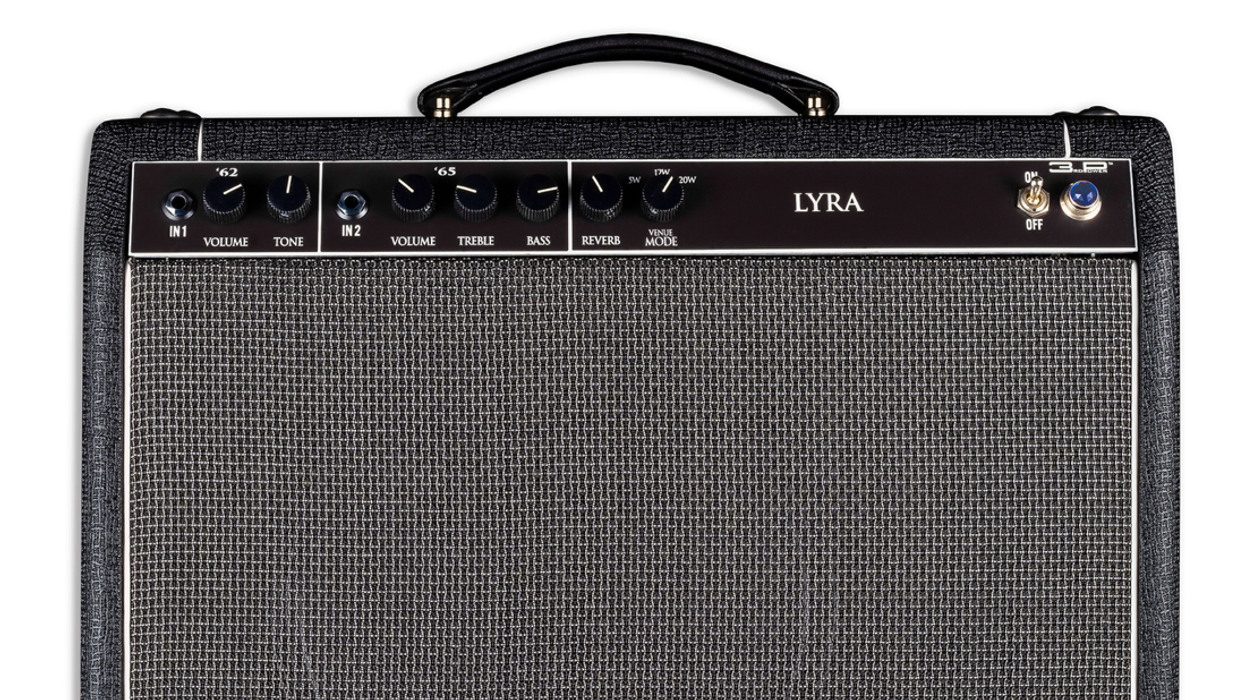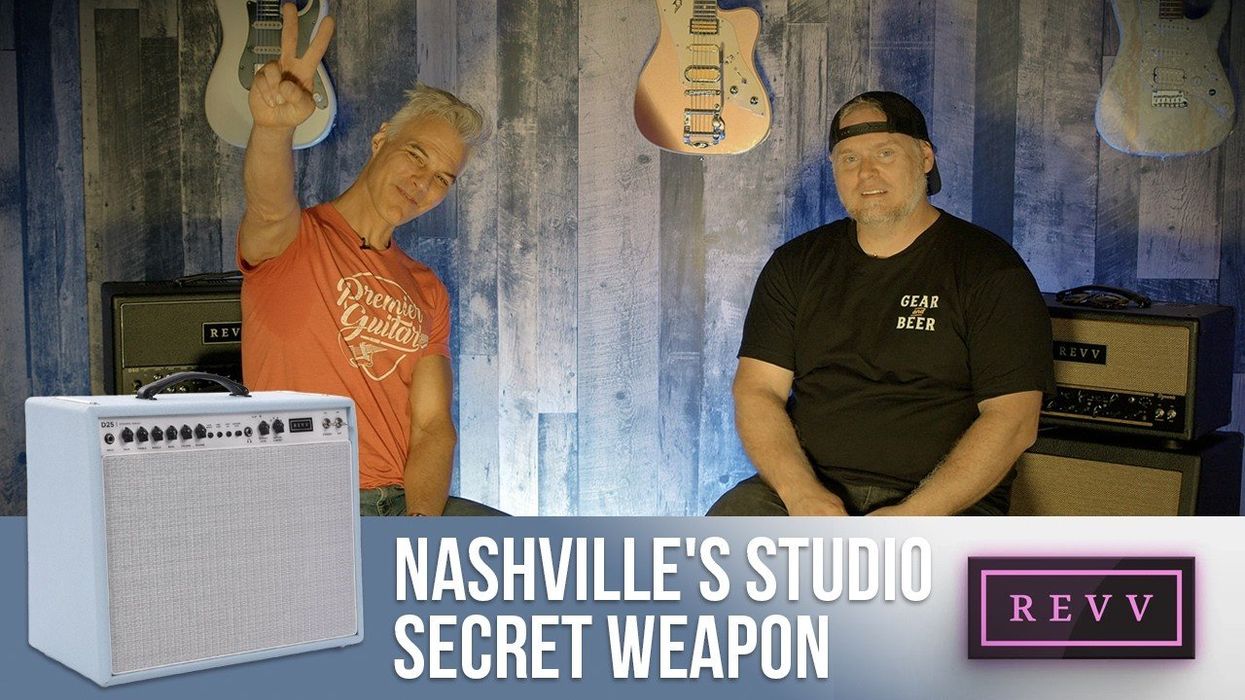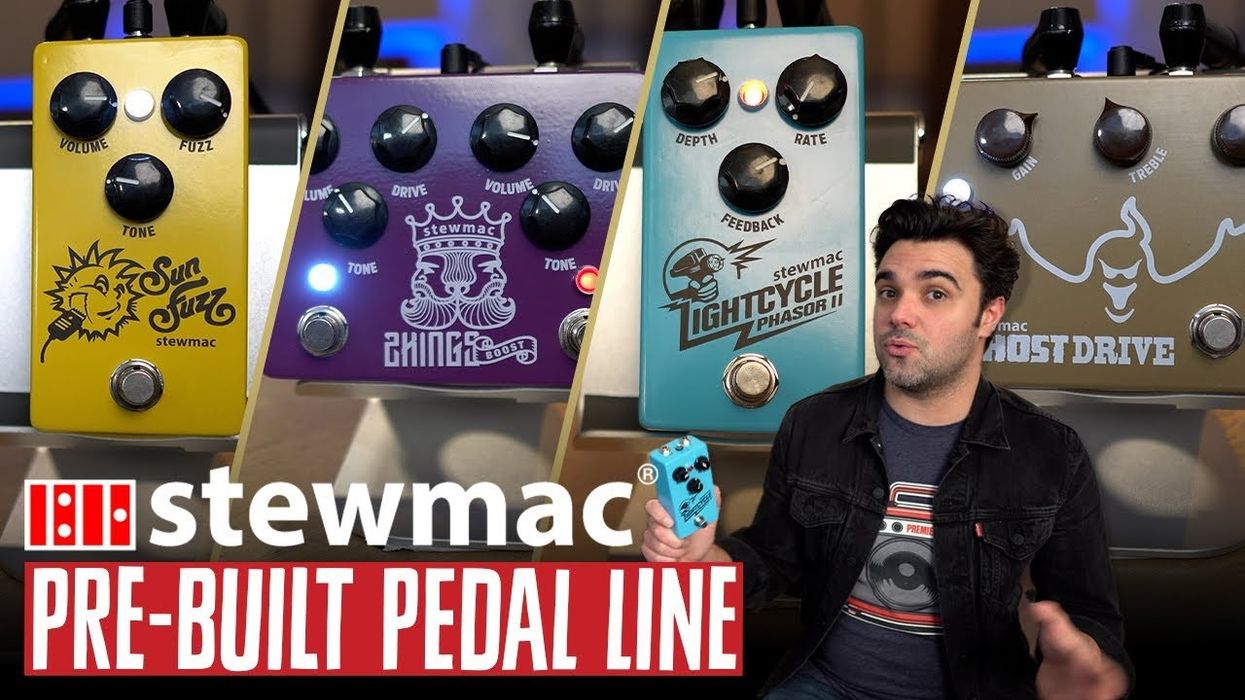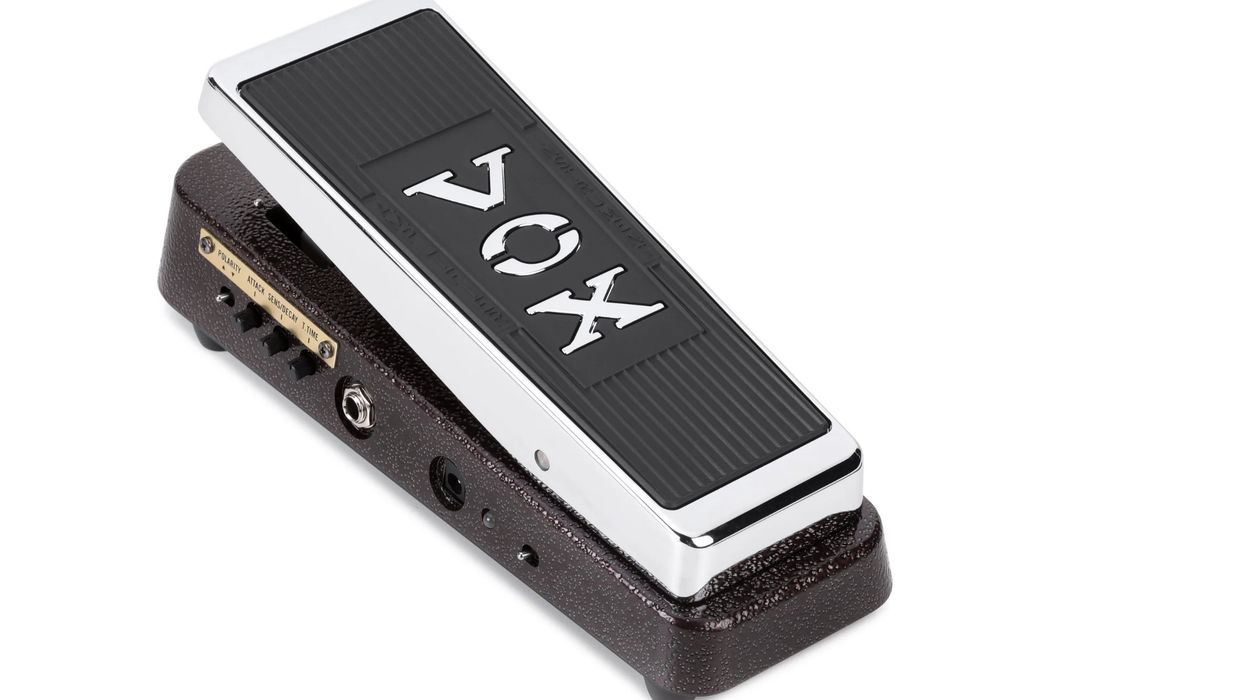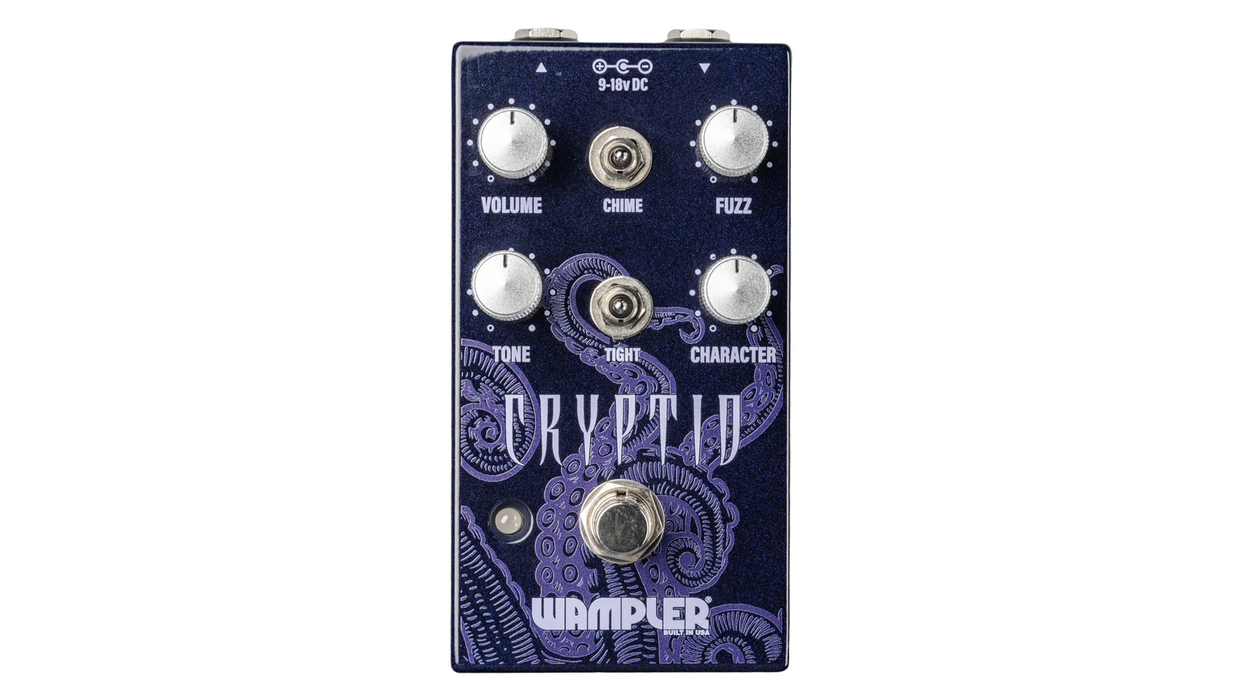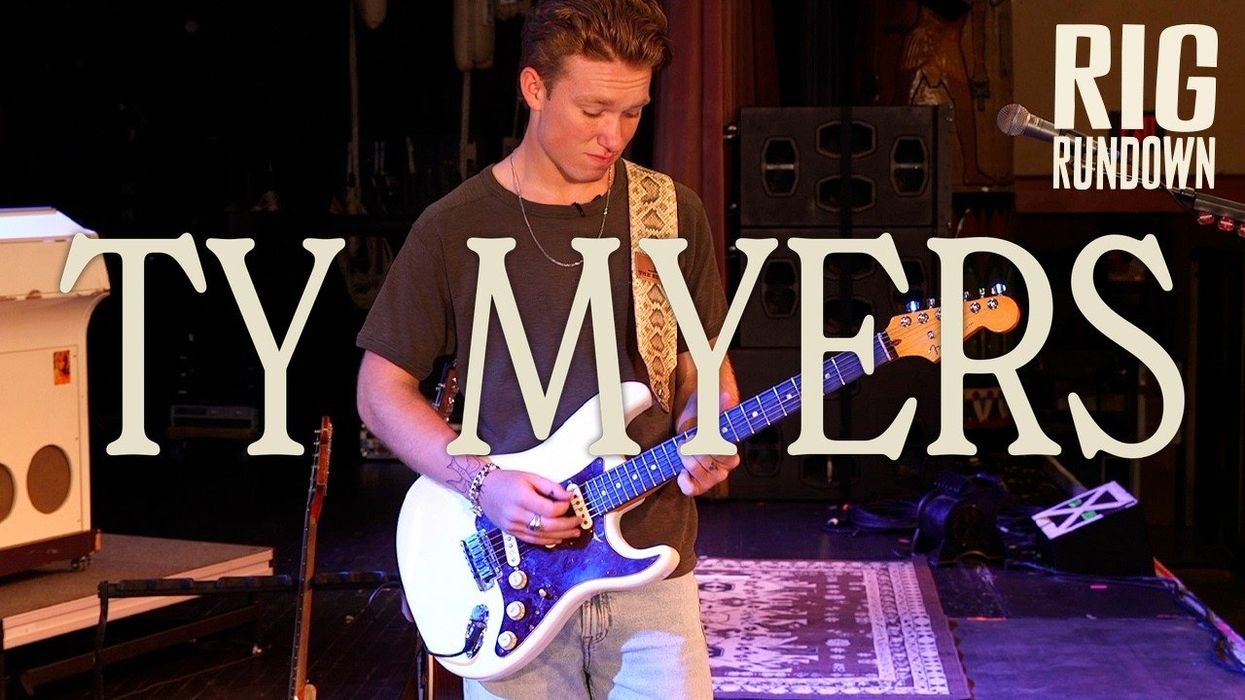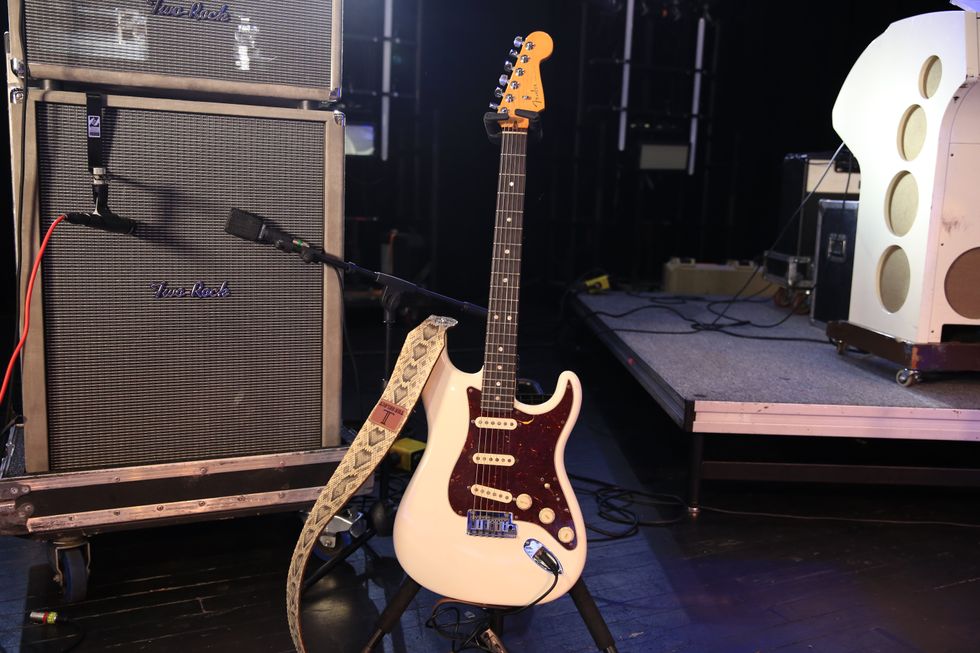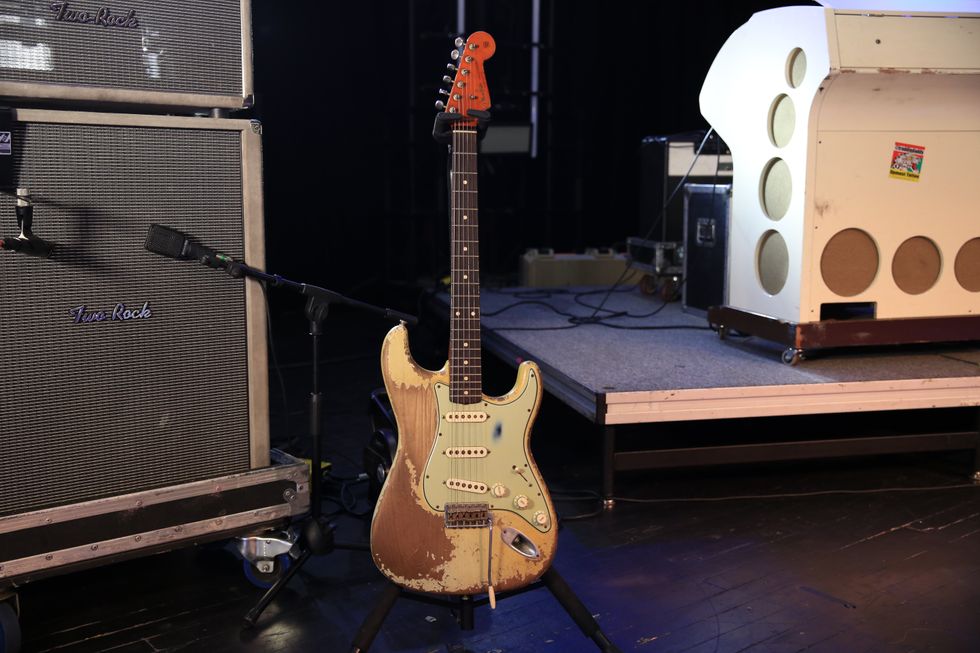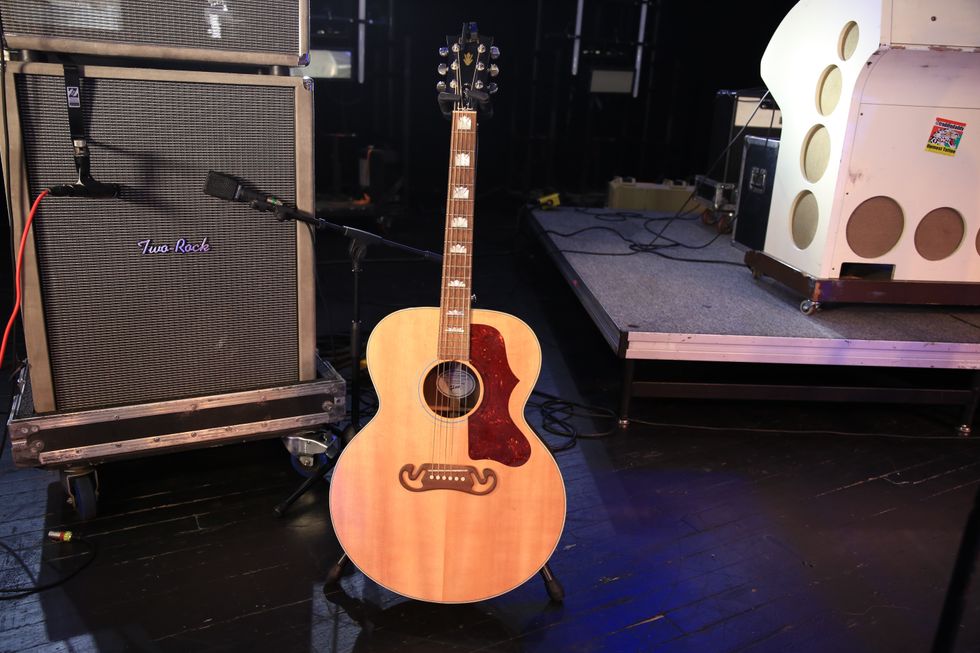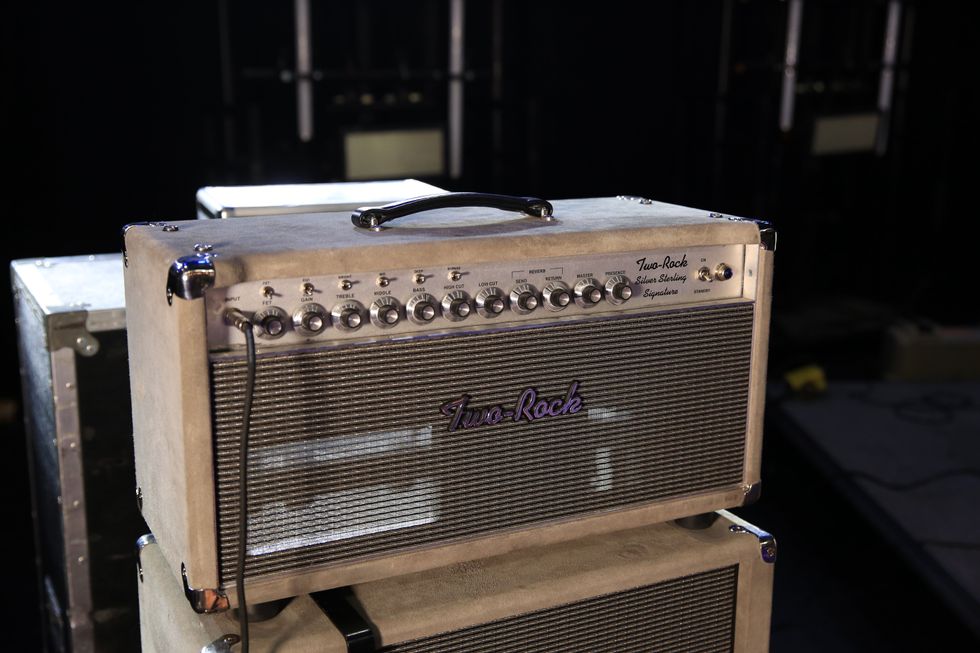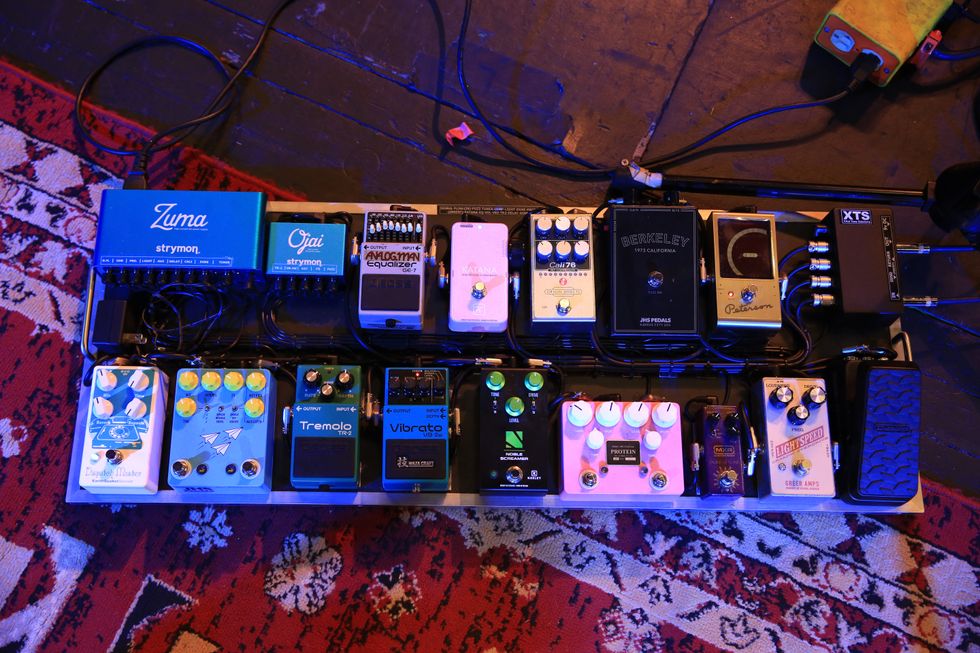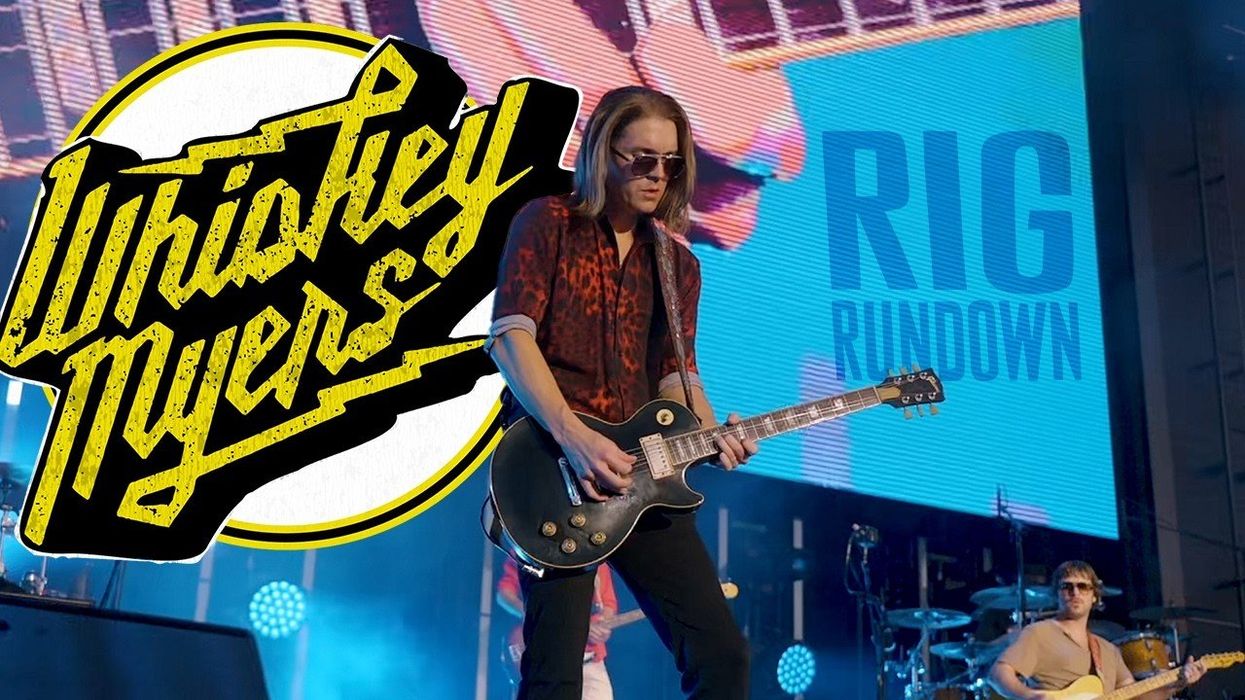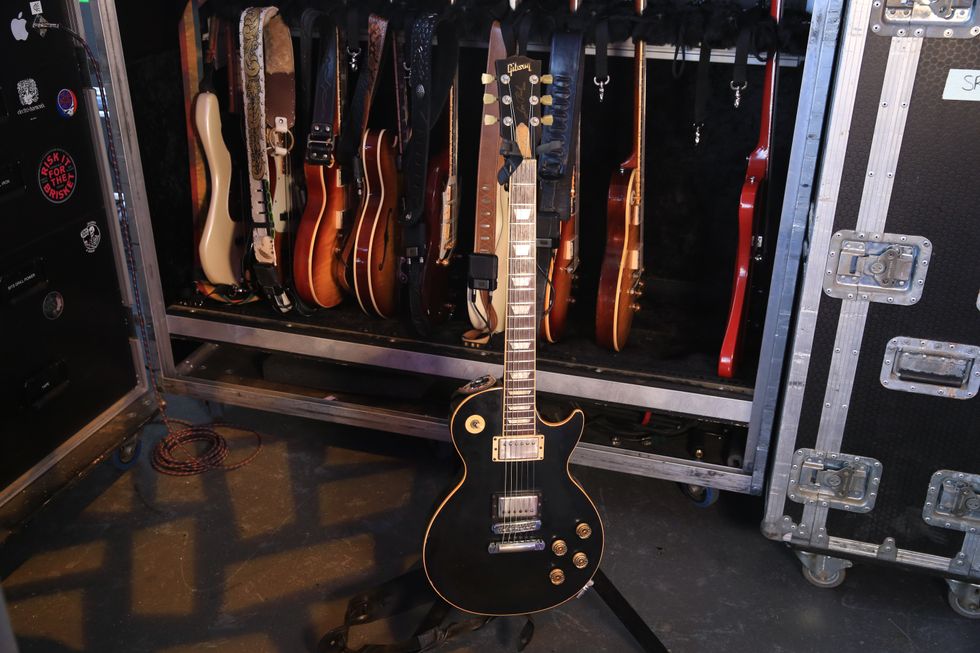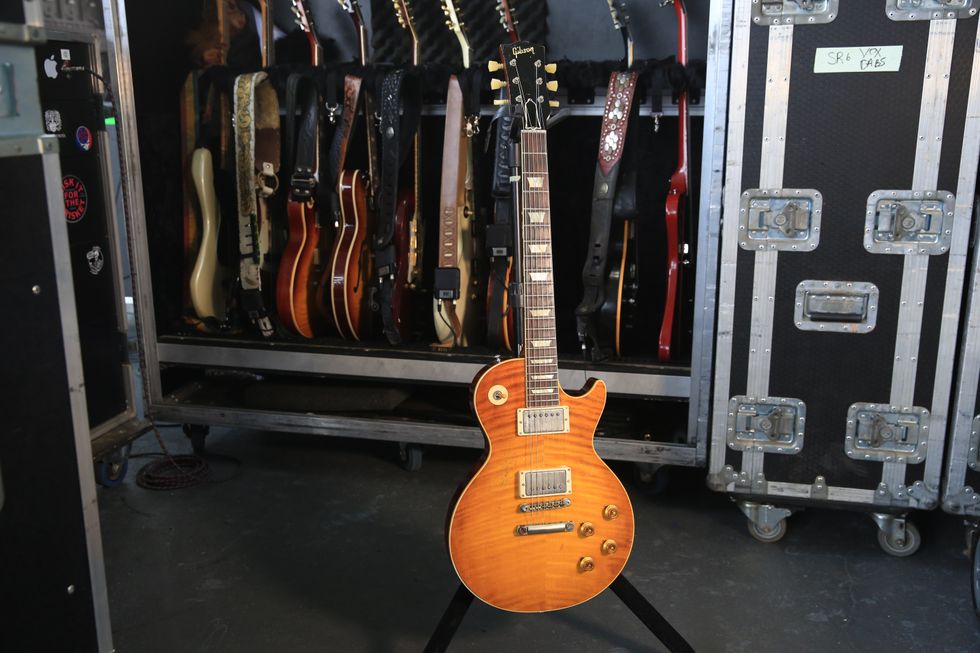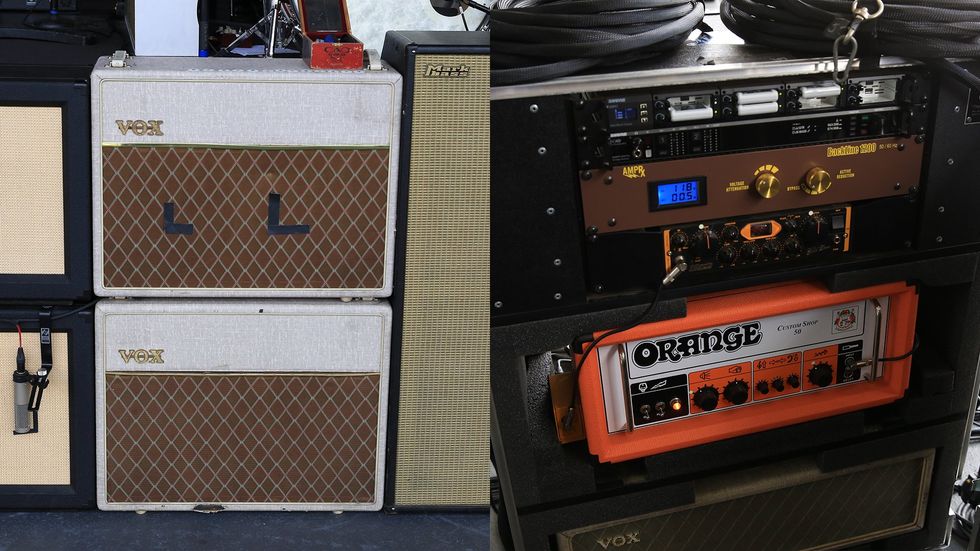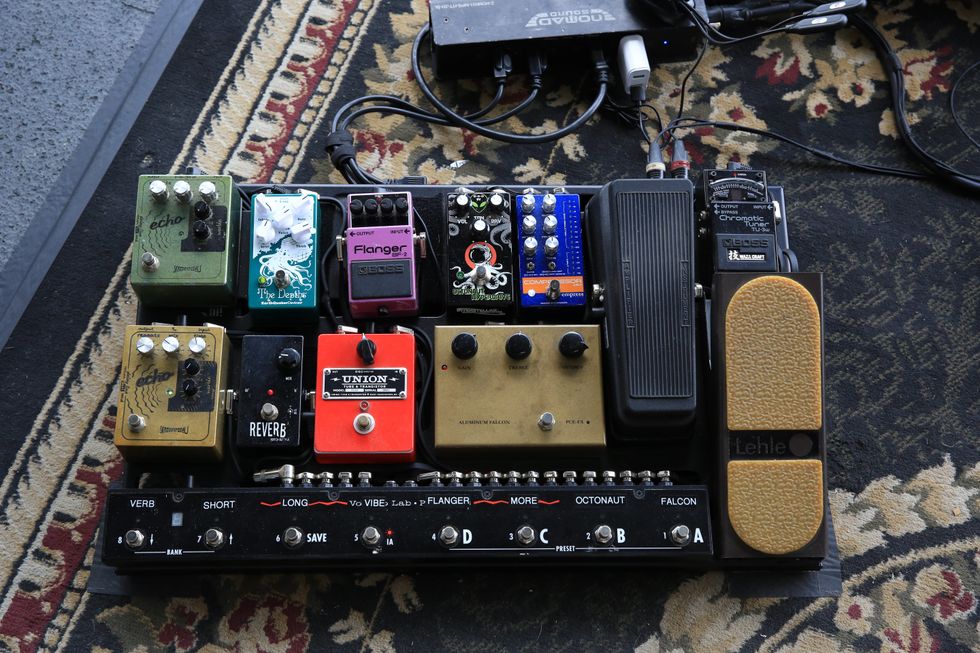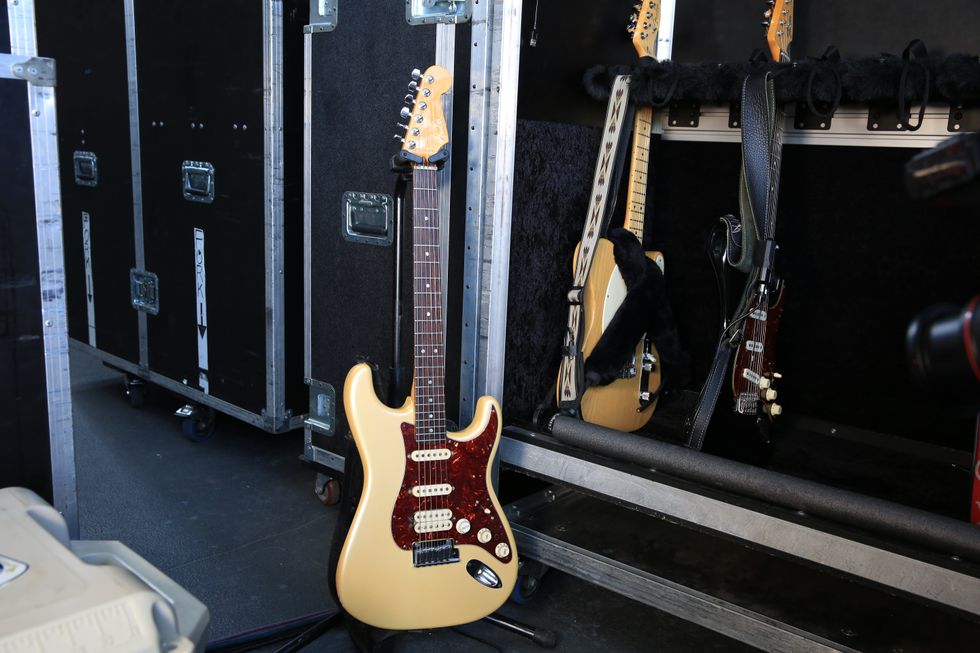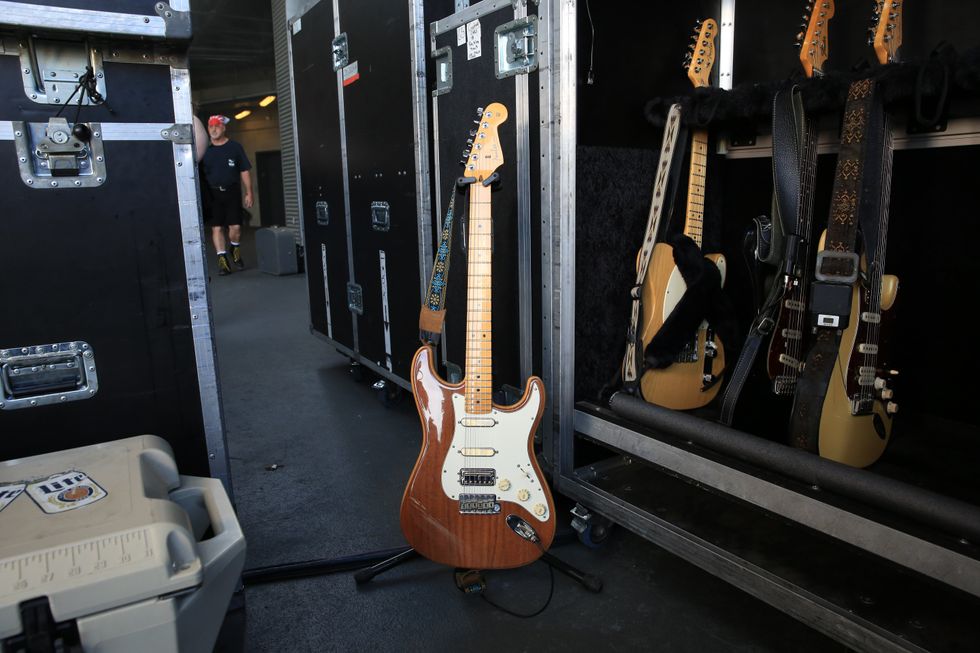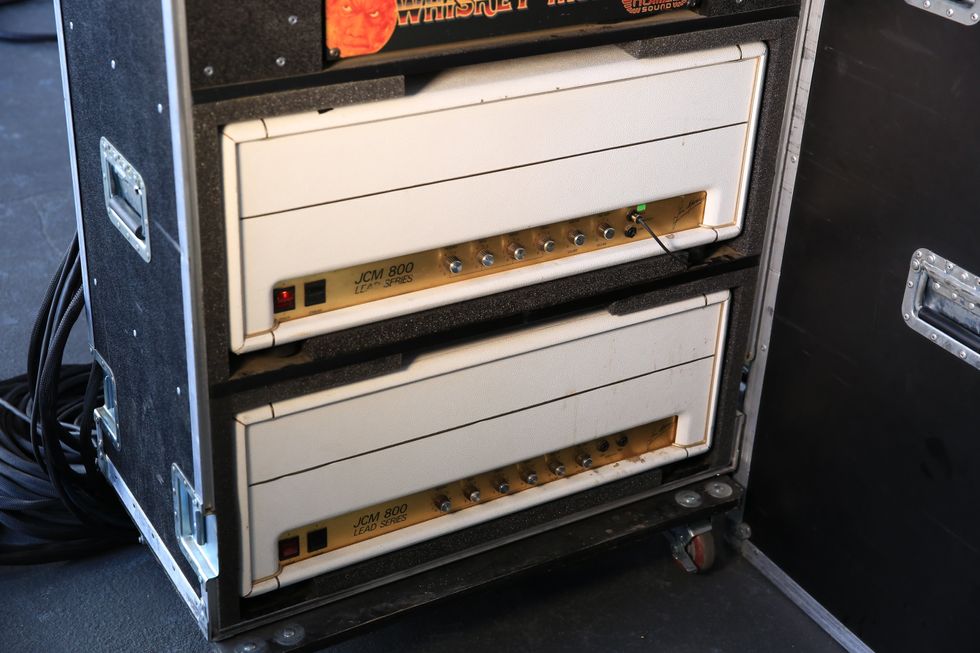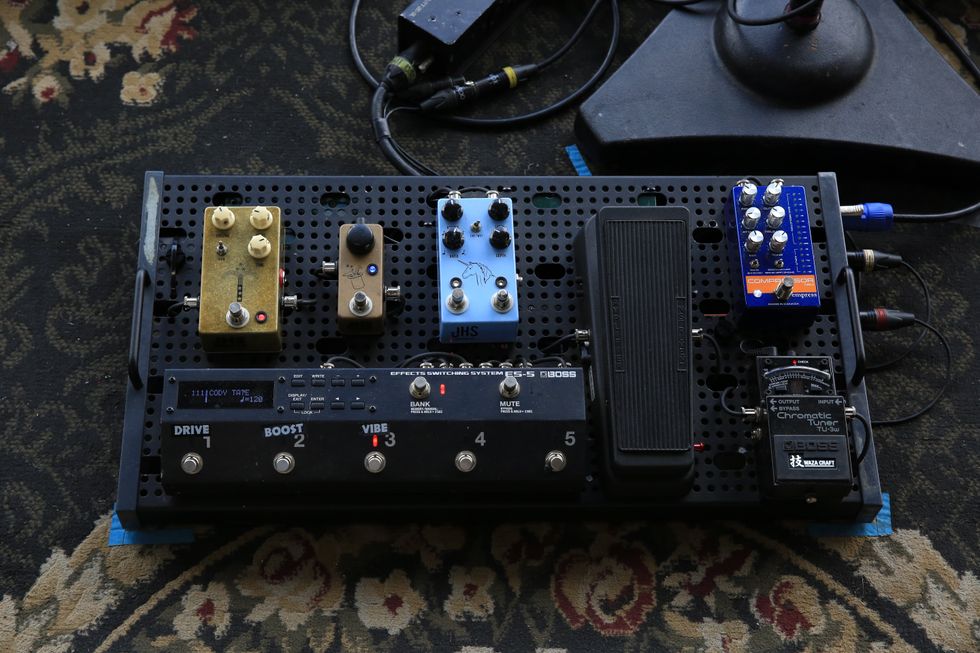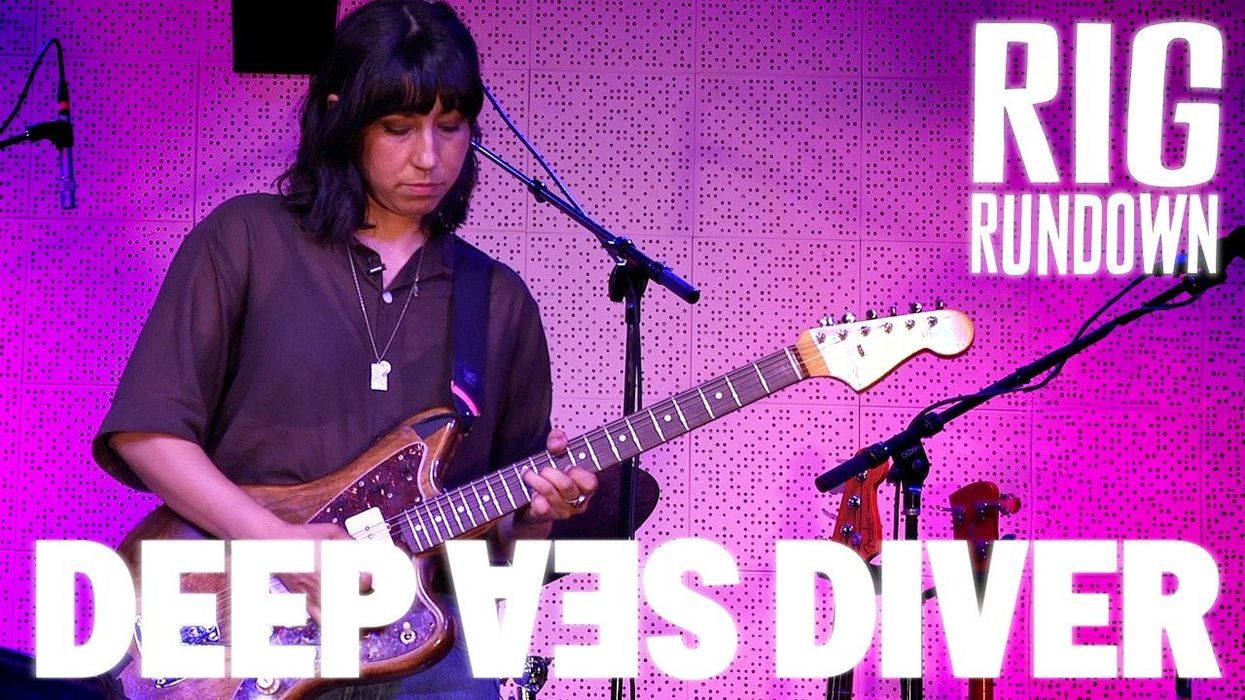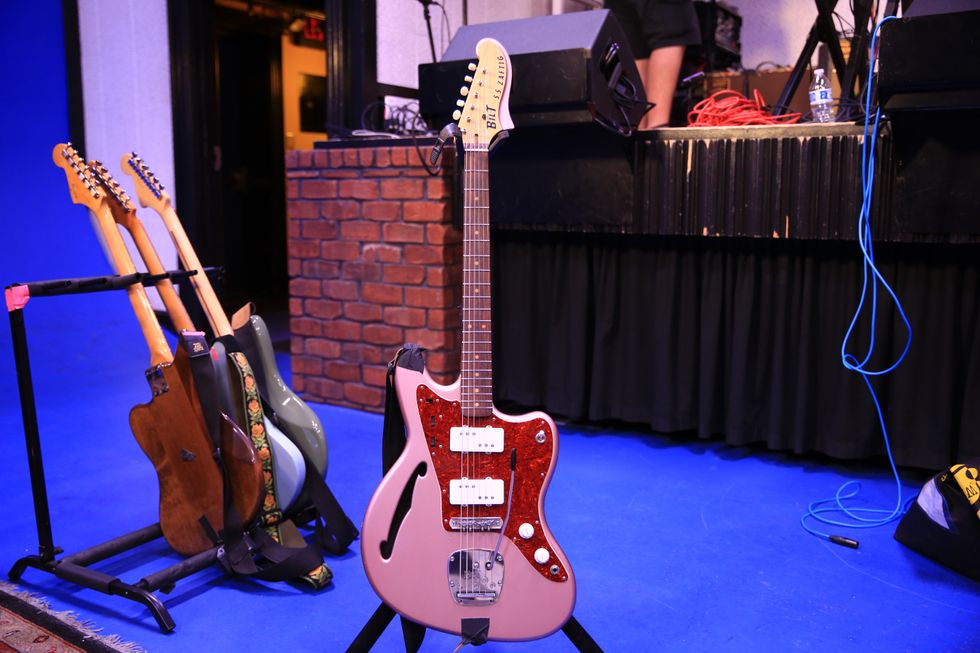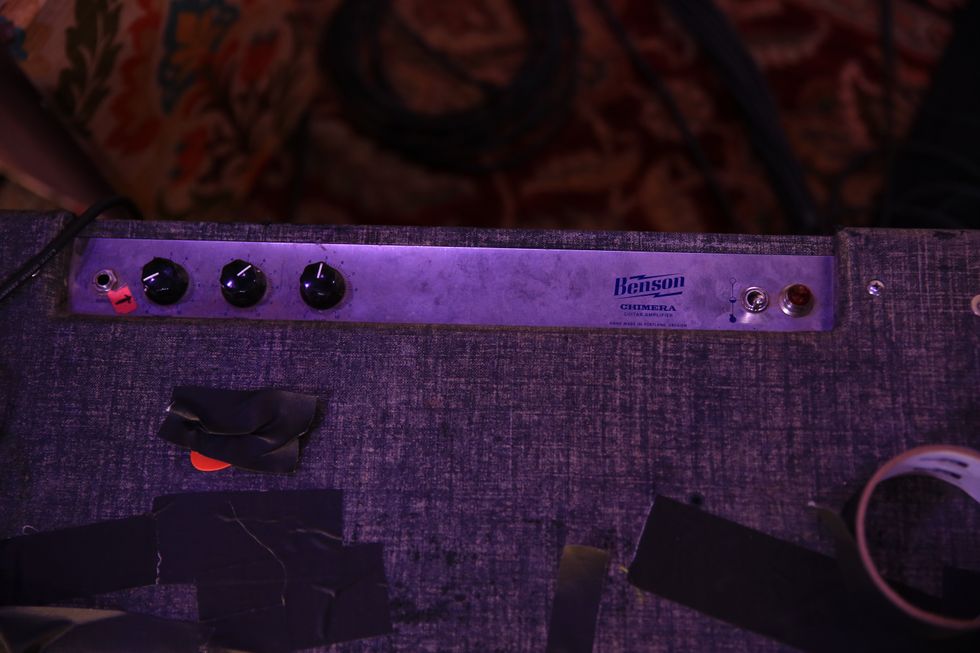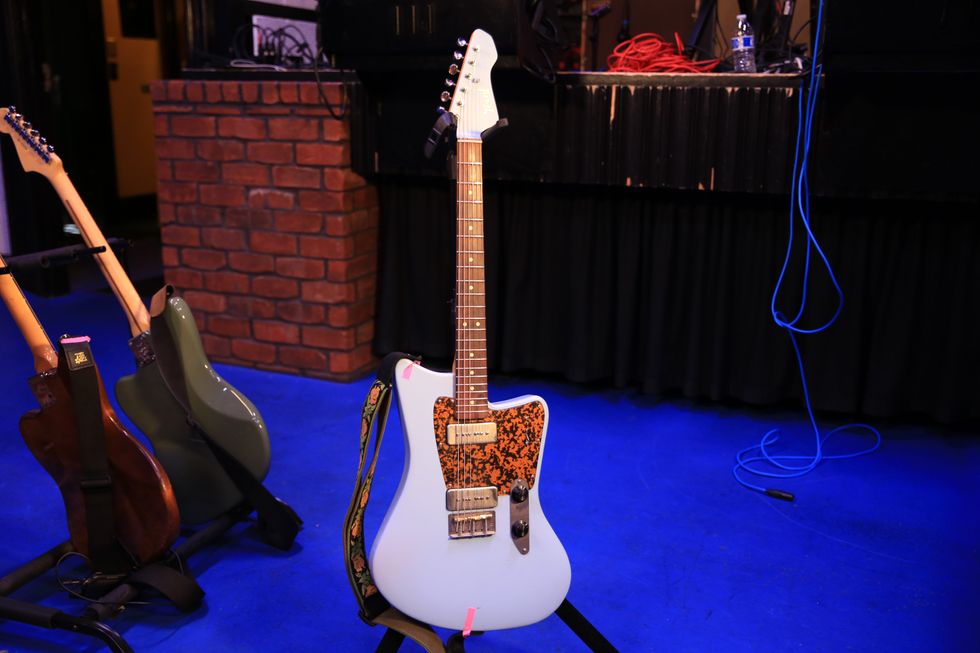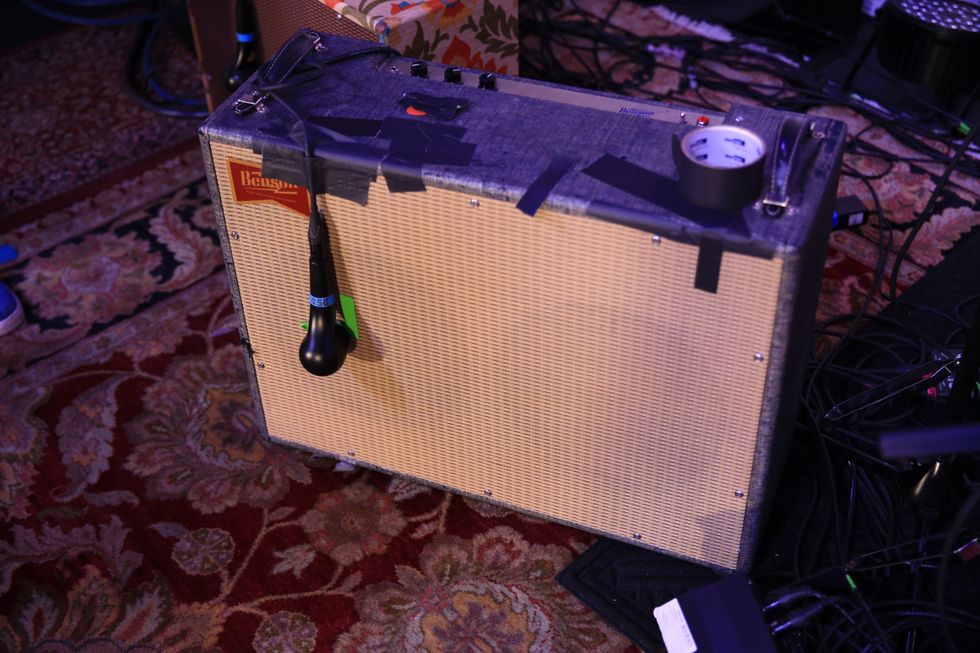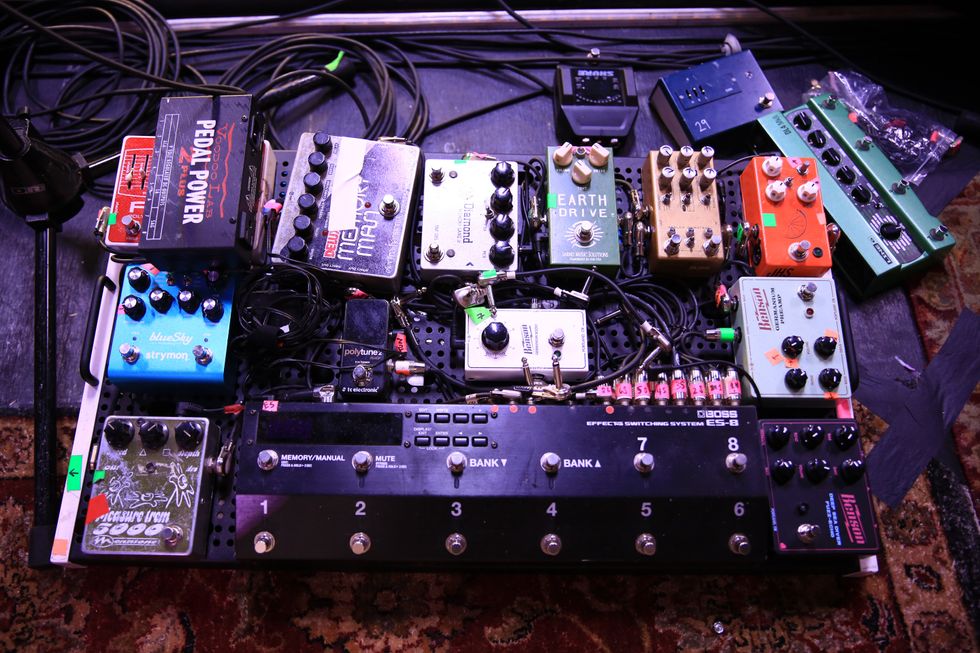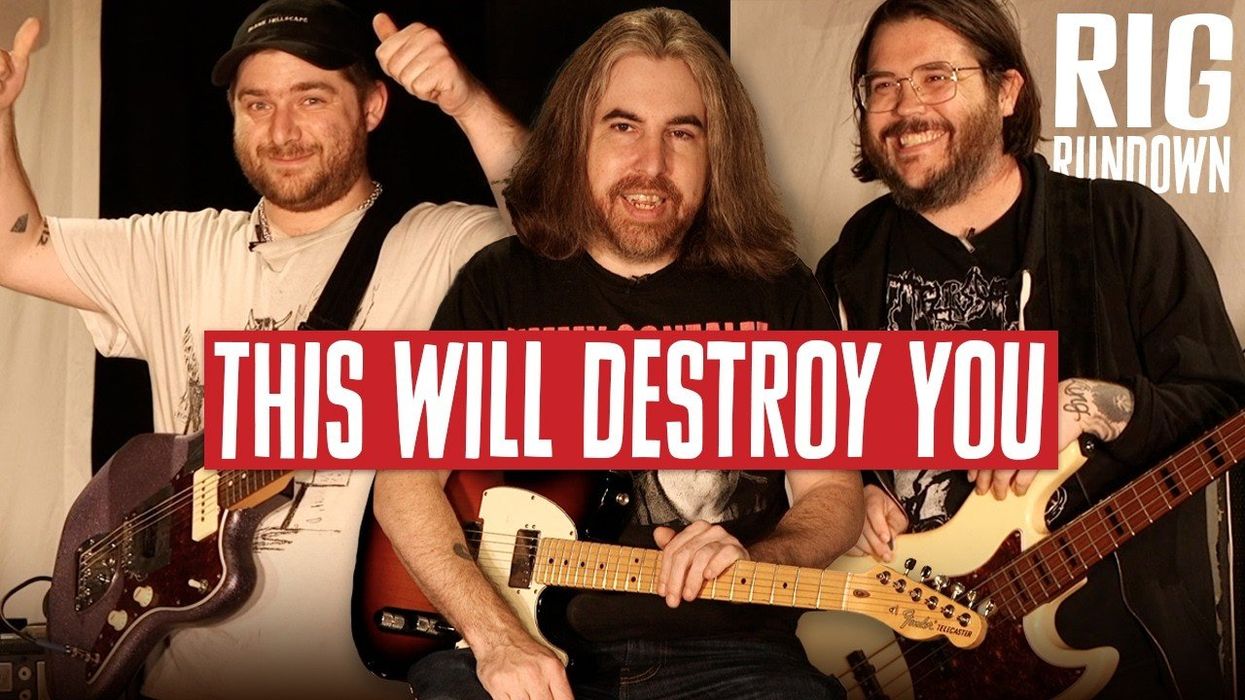Darkness, light. Silence, deafening volume. Intuition, intellect. In art, the balance between such contrasts has to be just right. Too stark, and things clash. Not enough, and the work is bland. But when the contrasting forces complement one another as well as guitarists Rory Kay and David Mena Ferrer of In Search of Sun, the creative outlook carries great potential.
Over the last three years, Kay, Ferrer, singer Adam Leader, bassist Faz Couri, and drummer Sean Gorman have worked relentlessly to forge a distinct musical identity. After releasing an EP under the name Driven, the band rechristened itself for the full-length debut The World Is Yours, ahard-rocking rollercoaster full of fluid leads, slamming riffs juxtaposed against plinking, cleanly compressed echoes, and a host of diverse tonal textures—often within a single song. Kay and Ferrer approach their playing and writing from very different mindsets, but their contrasting styles dovetail perfectly on ruthless power riffs, intricate high-speed patterns, and moments of austere beauty.
Roommates as well as bandmates, Ferrer and Kay were in their London flat watching Barcelona play Ajax in a UEFA Champions League match when we connected on Skype—an hour early because I’d screwed up the time. Undaunted, they shut off the TV, grabbed a couple of beers, and cheerfully demonstrated that their accommodating skill sets work as well in conversation as they do on the fretboard.
How did the songs on The World Is Yours develop?
Rory Kay: Most of the songs pretty much started with Dave and me. One of us would be playing a riff and the other one would just play something completely different, and we’d go, “Hold on, there’s some kind of magic happening there.”
David Mena Ferrer: But just because we’re the guitarists doesn’t mean we write all the guitar parts. I could write a vocal line, just as Adam could write a guitar riff. Everyone does everything, so we can get the best out of a song.
It seems like some of these tunes could work in other styles, not just metal. How have you developed as songwriters?
Kay: The EP we did as Driven felt more like a collection of riffs. For this album, it was more like, “This is what’s best for the song” and trying to get the bigger picture across.
Ferrer: “The Eyes Behind I” was kind of influenced by [Dutch DJ] Tiësto and trance music. I listen to quite a bit of trance and get influenced by the repetitiveness of that one line over and over again. If you're in a club, people just want to hear that line over and over again.
Kay: Now we’re even more influenced by that stuff, with what we’re writing at the moment. We come up with a riff, and people are, like, “That’s Daft Punk, man!”
Ferrer: We’ve already got five or six tracks [for the next album]. They’re not finished, but the ideas are there.
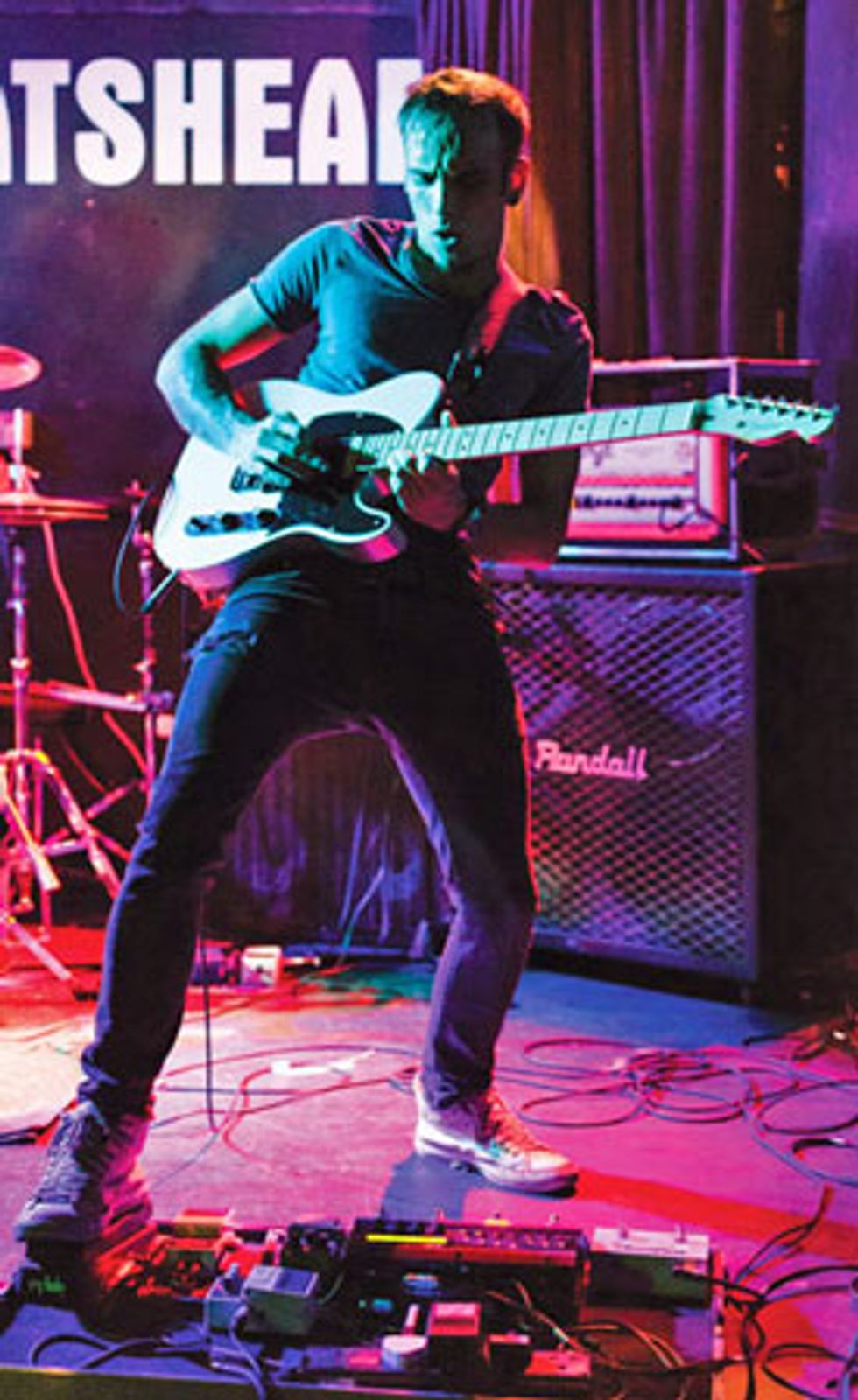
Photo by Malcolm Hynds.
How do your arrangements come together?
Kay: We do a lot of pre-production—we’re always recording. We’ll put the guitars into the Mac, and then someone will program some drums to see if it flows as a song. We might jam it in the studio, or one of us might jam with Faz. We keep adding parts. Vocals are
usually last.
Ferrer: Even with the vocals, we’ve been constantly doing preproduction. We had a year-and-a-half to work on [the album]. We constantly worked on the songs to make them better
So you aren’t of the “Write it, play it, print it” school?
Kay: We never really finish a song straight away. There would be countless vocal lines being put online for us to listen to. The song “51 56” had 40 vocal lines!
Ferrer: For about eight months, Adam and I worked together [at the same day job]. And all we would do during breaks would be to sit in his car, put the Mac on, and be like “Right: Vocal lines! Vocal lines!”—just every day for, like, six months.
Kay: I’d be at work and get a phone call, and it would be them. They’d put the phone up to the Mac, and I wouldn’t be able to hear it! [Laughs.]
Ferrer: I remember coming up with the chorus for “51 56.” We were in my car outside Adam’s house until like five in the morning, and we finally came up with it. He went and recorded it in some car park nearby, came back to my house at six, and got me out of bed. I went downstairs and put the headphones on, and we were just smiling. We just couldn’t stop listening to it for months.
Wait—he recorded the vocal in the car?
Kay: Yelling into his Mac! We all went to the car park once. It was outside a doctor’s office, and we’d see some doctor poking his head out the window. For a while, Adam made us get out of the car—he didn’t like singing in front of us—so it would be three dudes standing outside of the car and there’d be this guy inside going “AAAAAARRRRRRRHHHHH!”
Did you record final parts as a group in the studio?
Kay: We didn’t record as a band. There wasn’t space in the studio for that. For the album itself, drums were first: Sean would record to a detailed guide track, bass next, guitars, and then vocals at the end.
Photo by Chloë Faye.
Your individual styles work so well together. How did you develop as players?
Ferrer: I’m self-taught. I don’t know any scales. I don’t know any chords. I just play what I feel—what comes out of my head. I started late: I’m 29 now and began when I was 18. A friend of mine got a bass and he was, like, “Why don’t we start a band?” I’ll be honest with you, man—I literally didn’t know anything about guitar. I was a complete idiot. But I really enjoyed it. The first thing I learned was “Toxicity” by System of a Down, just little riffs like that—really simple stuff. I got really into it.
Kay: I started on classical guitar when I was about 11. I went through all the grades, and I think I did my grade eight by the time I was 15. At that point, I still wasn’t really grabbed by guitar. I enjoyed the stuff I was doing, but all the theory was rubbish. None of it was useful for constructing any kind of music—no context at all—but it obviously helped my fingering. I’d been playing for six years by the time I got an electric. My friend at school was into Iron Maiden and he got a guitar. I went around and played it, and I obviously had to get my own. My mum just got me some Deep Purple and Cream records, the Led Zeppelin II album, and that’s what set me off. I was a complete bedroom guitarist, just playing all night, learning stuff off YouTube. I did go to a university for a year, and that kick-started me into learning scales. But I’m pretty much self-taught when it comes to anything I actually use.
Rory Kay’s Gear
Guitars
2003 Gibson Les Paul Standard with Bare Knuckle Holy Diver (bridge) and Gibson 490R (neck)
’70s or ’80s Epiphone SG
Gibson Custom 1957 Les Paul Goldtop Darkback VOS
ESP M II
Ovation MOB57
Amps
Orange Rockerverb 50 head
Orange 4x12 and 2x12 cabs with Celestion Vintage 30s
Peavey 6505
Marshall 1960B cab
Divided by 13 FTR 37 combo
Effects
Dunlop Cry Baby wah
Electro-Harmonix Clone Theory
HomeBrew Electronics Tramp
Strymon TimeLine
MXR 10-Band EQ
Ibanez TS9 Tube Screamer
ISP Decimator G String
Boss TU-3 tuner
Strings and Picks
Ernie Ball Heavy Top Skinny Bottom strings
Various 1 mm picks
David Mena Ferrer’s Gear
Guitars
Fender Telecaster with Seymour Duncan Pearly Gates (neck) and ’59 (bridge)
Epiphone Les Paul “Black Beauty” with EMG 81 (neck) and 85 (bridge)
Amps
Orange 4x12 and 2x12 cabs with Celestion Vintage 30s
Peavey 6505
Marshall 1960B cab
Divided by 13 FTR 37 combo
Effects
DunlopCry Baby wah
Boss TU-3 tuner
Ibanez TS9 Tube Screamer
Boss NS-2 Noise Suppressor
TC Electronic Nova System
Strings and Picks
Ernie Ball Regular Slinky (Tele)
Ernie Ball Heavy Top Skinny Bottom (Les Paul)
Dunlop 1.38 mm Max-Grip Jazz III picks
Who were your main influences?
Ferrer: Most of my friends were in bands, so my main influences would be the people I grew up with who taught me stuff. When it comes to big names, I’d say Dimebag Darrell is probably my favorite. Man, you don’t get heavier with that much tone. John Frusciante is another favorite. Even though he’s quite simple at times, he makes it sound beautiful. Everything doesn’t have to be really complicated.
Kay: My biggest influences were probably Zakk Wylde and Dimebag, although I could never play anything that Dimebag played—and still can’t [laughs]. I’m also massively influenced by anything blues.
Even though you have some similar influences, your approaches seem pretty different. How do you make them work together?
Kay: Dave might just play something that sounds good to his ear, and I play something that I think might fit, or vice versa.
Ferrer: Sometimes that can be a pain in the ass. The other guys will be like, “What beat [time signature] is that in?” And I honestly don’t know [laughs].
Kay: But we always get there in the end.
Everything sounds so tight.
Kay: That would have to do with the producer, Phil Kinman. He was very meticulous, and that rubbed off on me quite a lot. We wouldn’t move on if it wasn’t perfect. And that’s why it’s so solid.
How did you get that big sound?
Kay: We might not necessarily have been using our own gear. Anything that was riff work—that wall-of-sound stuff—we doubled. We even quad-tracked the heavier stuff. For the more intricate parts, we were mucking about with different guitars, pickups, and amps. A lot of the clean stuff has acoustic guitar on top of it.
Ferrer: We used delays and different sounds, too. I do love my delays, just to create that atmosphere. Like in “In Search of Sun,” we started that song without any delays—just the raw sounds—then we started playing around with delays and got that ping-pong delay that sounded amazing.
What about amps?
Kay: We’ve both got Orange Rockerverb 50s with 4x12 Orange cabs at the moment. For the raw sounds, we went with the Rockerverbs. We also had a Peavey 6505 in the studio. We had to get something out to the PR company, so we did a rough track with the Peavey—and it was more of the metal sound we were after. We wanted a less distorted tone, so we layered the Peavey and the Orange amps. It’s so well recorded that it sounds quite big on the first track, “The World Is Yours.” The difference in the amps really makes the parts blend. We also used a boutique amp called Divided by 13. Its cab has two different speakers and the blend worked really well. When the amp is pushed, it has this really nice crunch to it. We used it on the beginning of “Skin” for that slightly distorted tone. It’s my favorite amp that I’ve ever played. For some of the clean stuff, we used Waves plug-ins and they worked well.
Did you mic the amps as the tracks went down or reamp?
Kay: We recorded all the guitars straight into the producer’s equipment and reamped everything, which is a great way of relaxing and not worrying about the tones. We were monitoring off of plug-ins—I think they were the Line 6 amp modelers that came with Cubase. When we wanted to create feedback, we had to be in the room with the amp, but we saved those parts until the very end.
Photos by Sean Friswell.
What guitars did you use on the album?
Kay: The producer had a lovely Les Paul Standard Goldtop, which I used for most of the solos. We also used my Les Paul. We borrowed a Strat for a lot of the clean tones, which worked really well. We just used anything that worked: For “Skin,” I needed a Floyd Rose, but mine broke before we went to record it. The producer had an ESP—I can’t remember which one. It had these Duncan Designed pickups, but it sounded great.
Did you use your own pedals in the studio?
Kay: There were parts we had to play with wah pedals and stuff. When we reamped, we also used a Tube Screamer, which we use live. For “Idle Crown,” I used my Strymon Timeline in the verse bits. It’s got a really beautiful ice effect—which you can’t really hear unless you put headphones on [laughs].
Ferrer: I have a TC Electronic Nova system, and we used some of the delays and tremolos from that, too. I already had the delays set for live purposes, so I just used them.
Speaking of live, how are you replicating the studio effects onstage?
Ferrer: I pretty much just use the Nova system. For each song, I have my delays and all the things I need, and after every song I press the bottom for the next bank. For some tracks, I’m tap dancing—bam bam bam bam bam. When we first started recording the album, I was like, “How the fuck am I gonna be able to play this live?! I have to press these four things!” [Laughs.] But by practicing, we can just do it without thinking about it.
Kay: We are looking to simplify stuff, but it’s all about money at the end of the day. We live with a guitar tech, and he’s always telling us about these MIDI switching systems where all the stuff is in the rack and you’ve got one board. We’re still quite young in terms of all the equipment we have.
Ferrer: There’s not a place I can go to try new stuff out with your own gear in England. You need to either get it and take the gamble, or borrow something.
Kay: Everything we have we’ve borrowed first.
A lot of the guitar parts on the album sound pretty challenging to play onstage.
Kay: We had to learn to make it work live—we really, really did. The songs were quite hard for us to get across and still have the same energy. We’re known for having a lot of energy. It’s hard to keep that momentum going when you’re standing there staring at your fingers and you’re, like, “Shit, here comes that hard bit!” Literally, practice and playing more gigs …
Ferrer: Practice makes a difference. There are practices where we’re just headbanging, trying to get as much energy as we can. But there’s nothing like playing live. A gig is always going to be different. We’re in the middle of a tour, and we feel a lot more comfortable every show.
Kay: There’s a lot of layered stuff, but parts-wise, nothing really gets left out. In terms of the sound, we obviously can’t replicate everything we did on the album—we don’t have all the same equipment—but we try to make it work. I might use a tremolo or something that I didn’t use on the album because it sounds good live and fills the gaps.
Ferrer: For example, when I play some of the clean parts live I use a Tube Screamer, because it jumps out more. At some of the venues we play, if I just have it clean, you would not be able to hear me. So having that little bit of crunch makes it work.
YouTube It
Hear the complementary tones of David Mena Ferrer’s Tele and Rory Kay’s Les Paul in the title track from their new album.
Given how intricate some of the parts are, is there any room for improvisation?
Kay: Not within the band or the structure of the songs. Solo-wise, I might play something completely different, but we don’t just go out and jam.
Ferrer: We think of the set as a whole show, and we work on it, work on it, work on it until it’s ready. We want to get to a level soon where we can play the songs to a click and have imagery locked in with the music.
Kay: We’ve also started using sounds to fill in the gaps between songs. Right now we’re just using our pedalboards, but we want to get Sean to start using triggers to play samples, too. We’re always looking to big-up the live show as we get ready for bigger stages—instead of being just five dicks running around onstage [laughs].

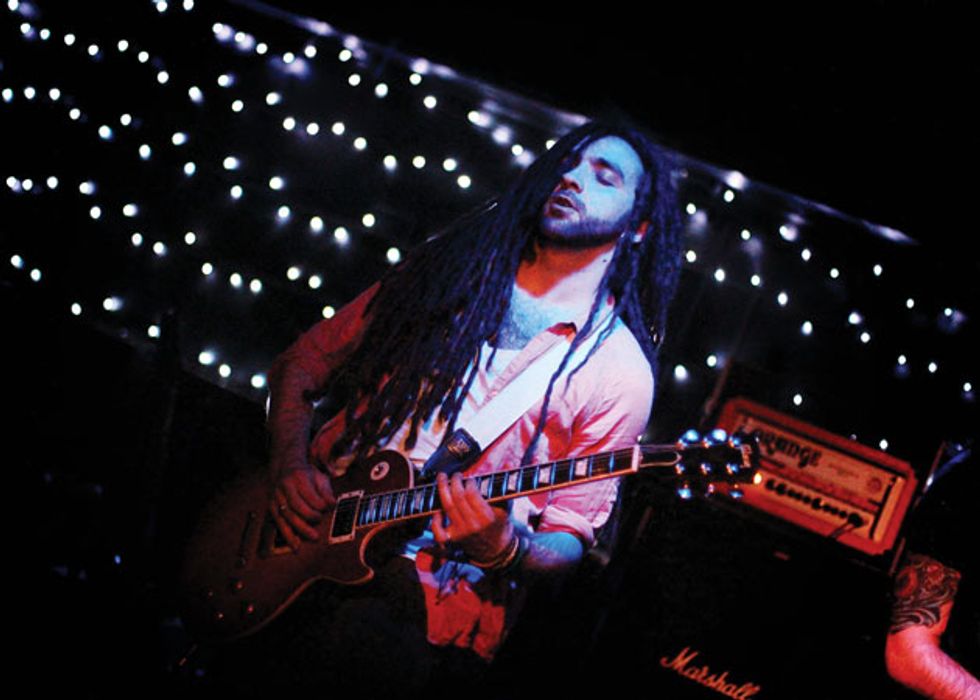
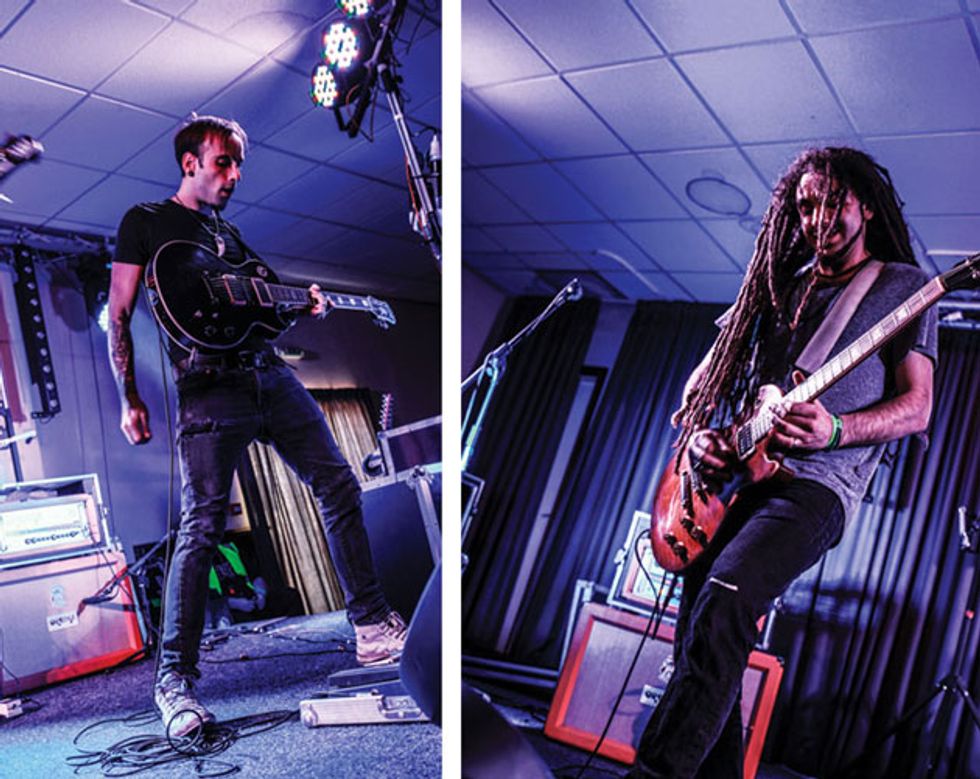
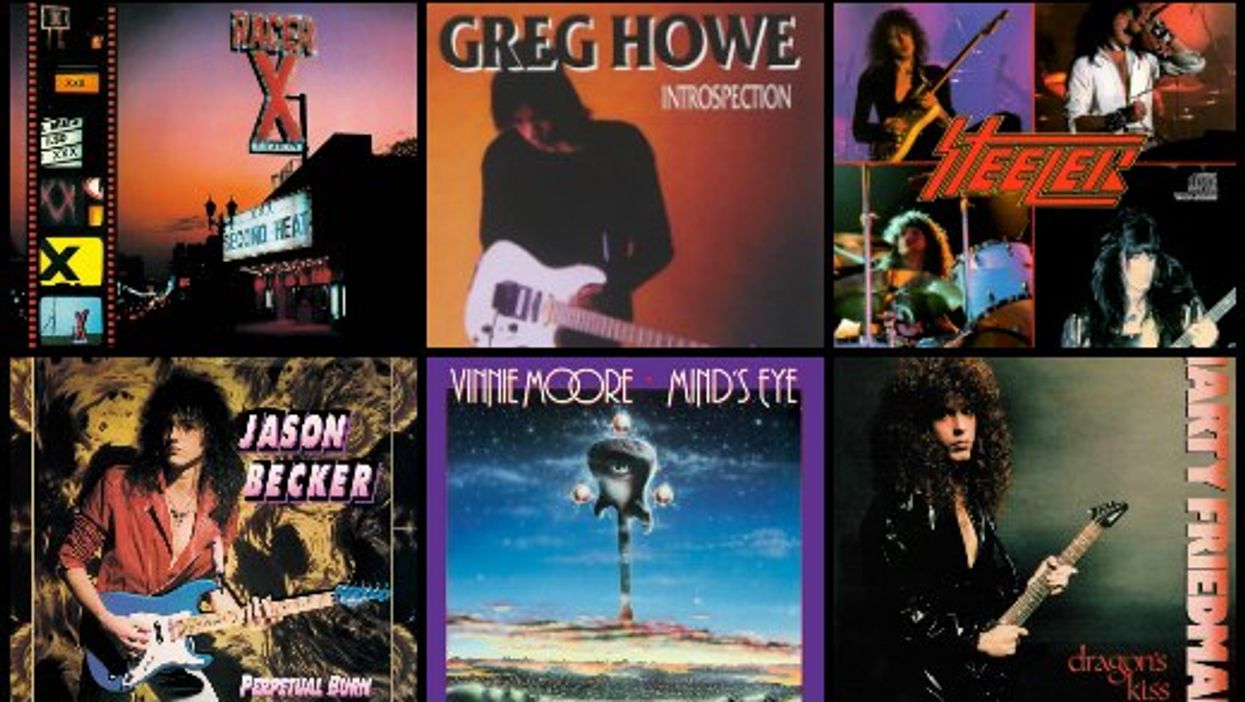
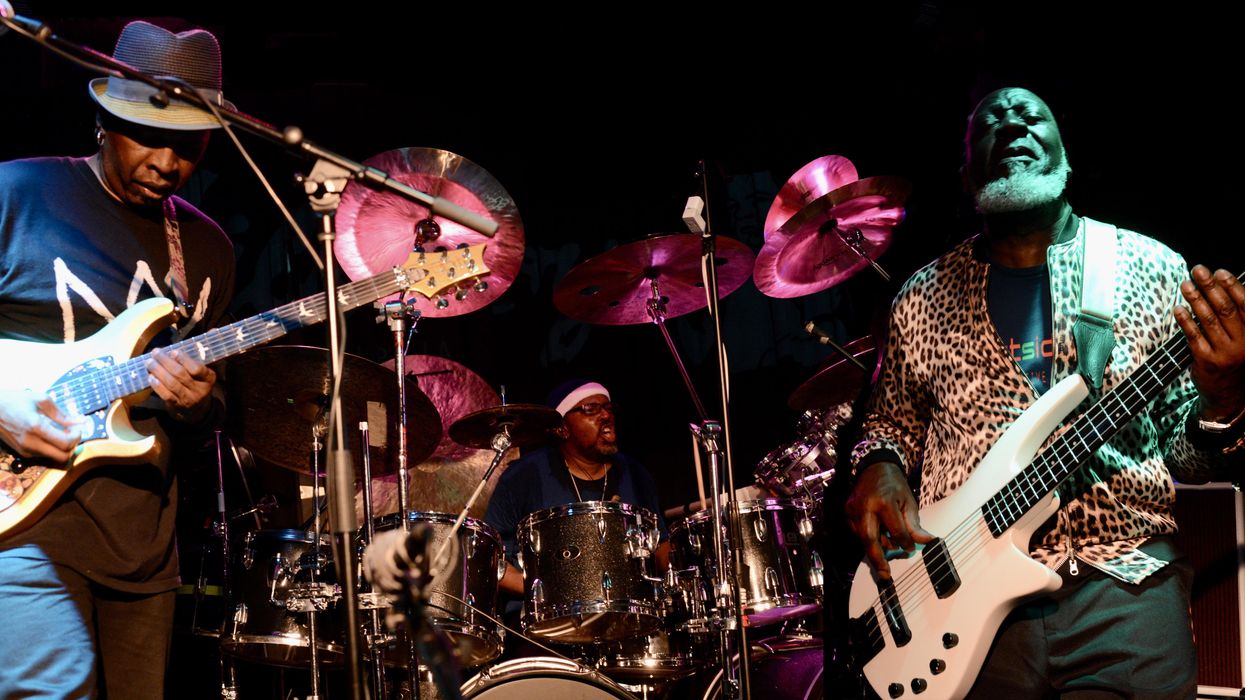


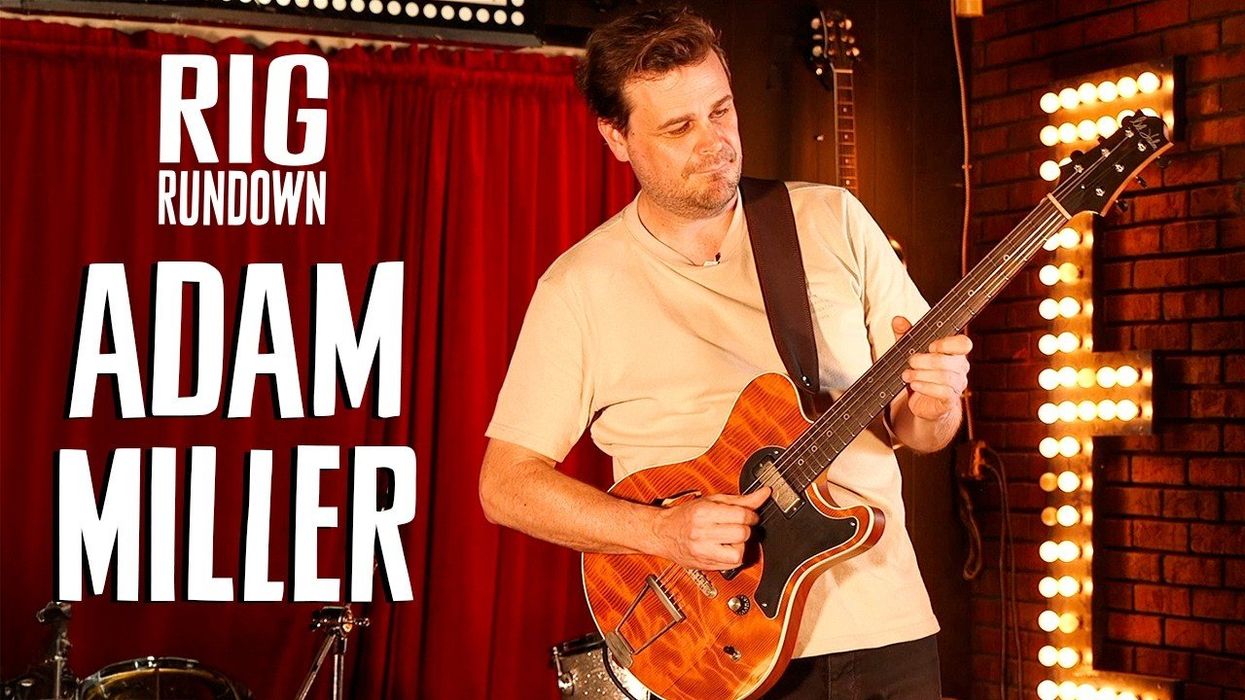
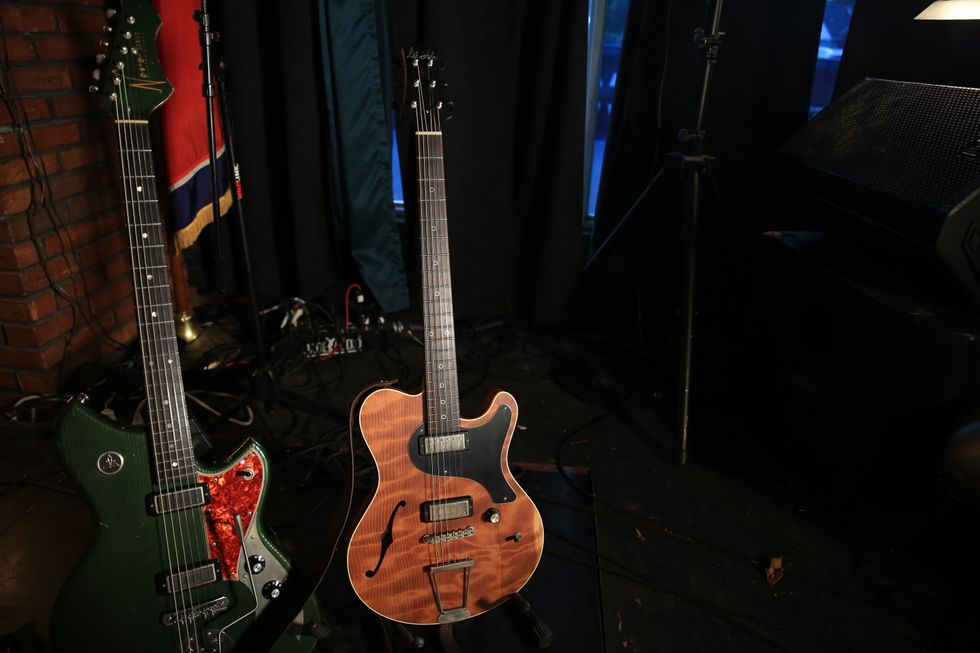
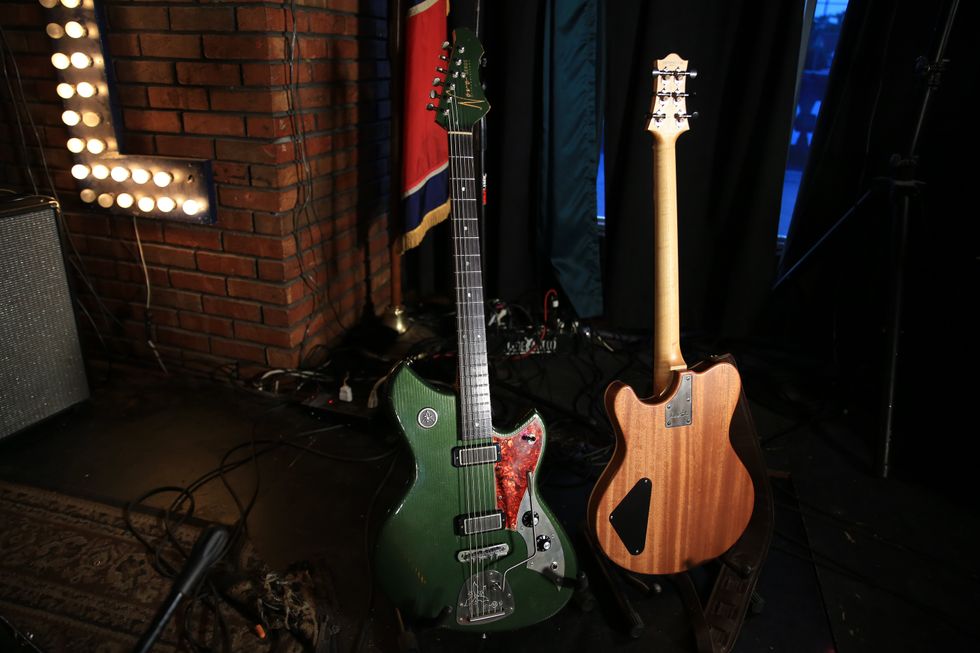
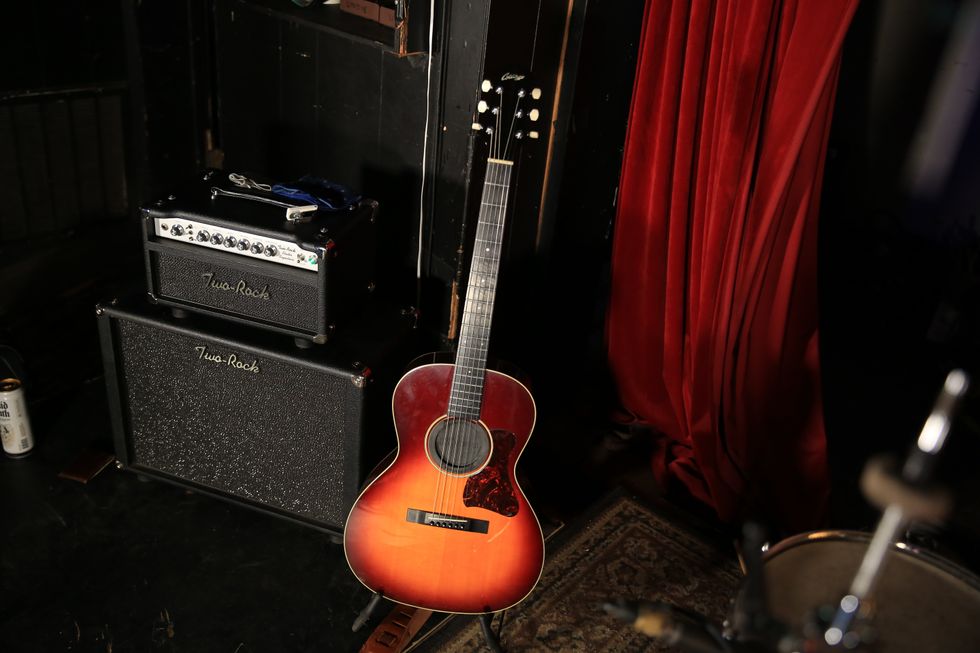
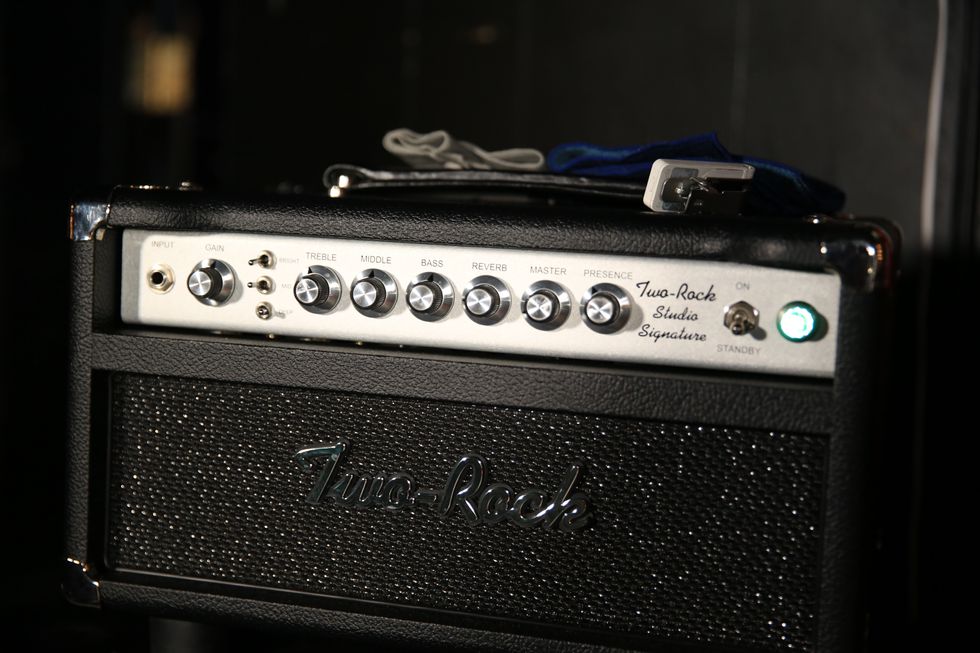
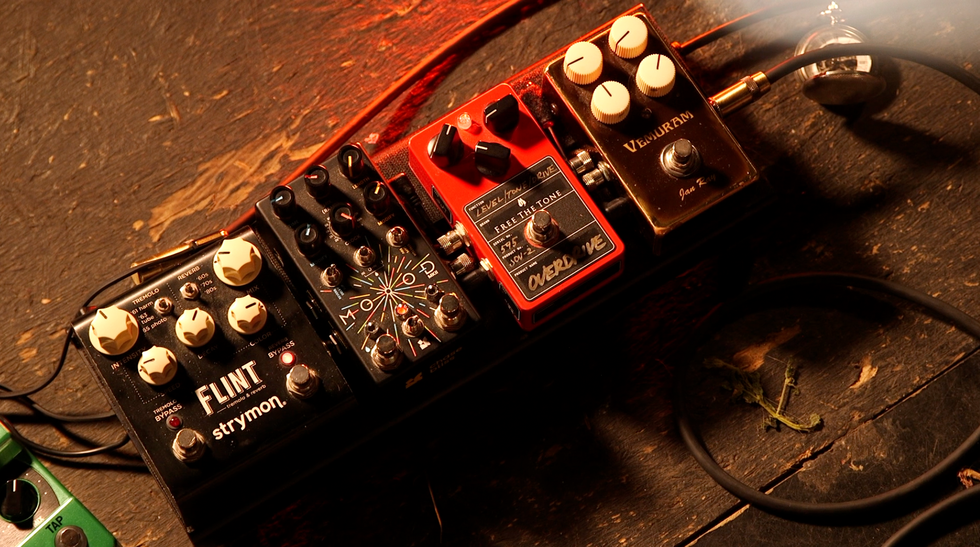
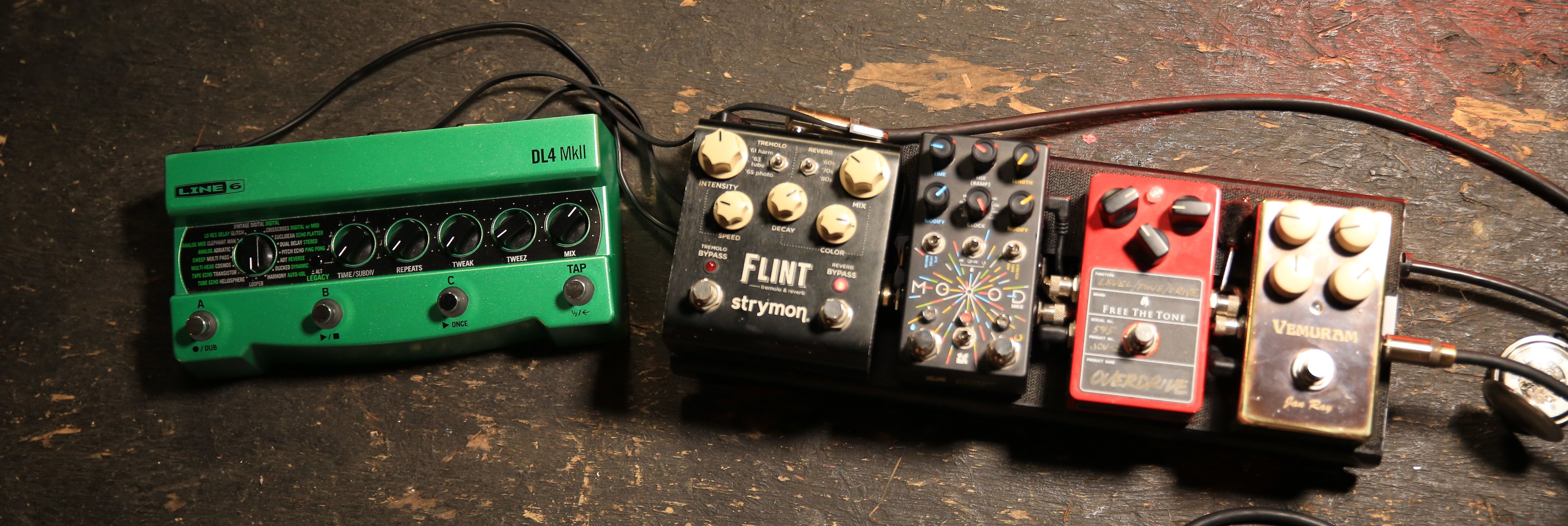 Miller’s Collings runs into a Grace Design ALiX preamp, which helps him fine-tune his EQ and level out pickups with varying output when he switches instruments. For reverb, sometimes he’ll tap the
Miller’s Collings runs into a Grace Design ALiX preamp, which helps him fine-tune his EQ and level out pickups with varying output when he switches instruments. For reverb, sometimes he’ll tap the 
